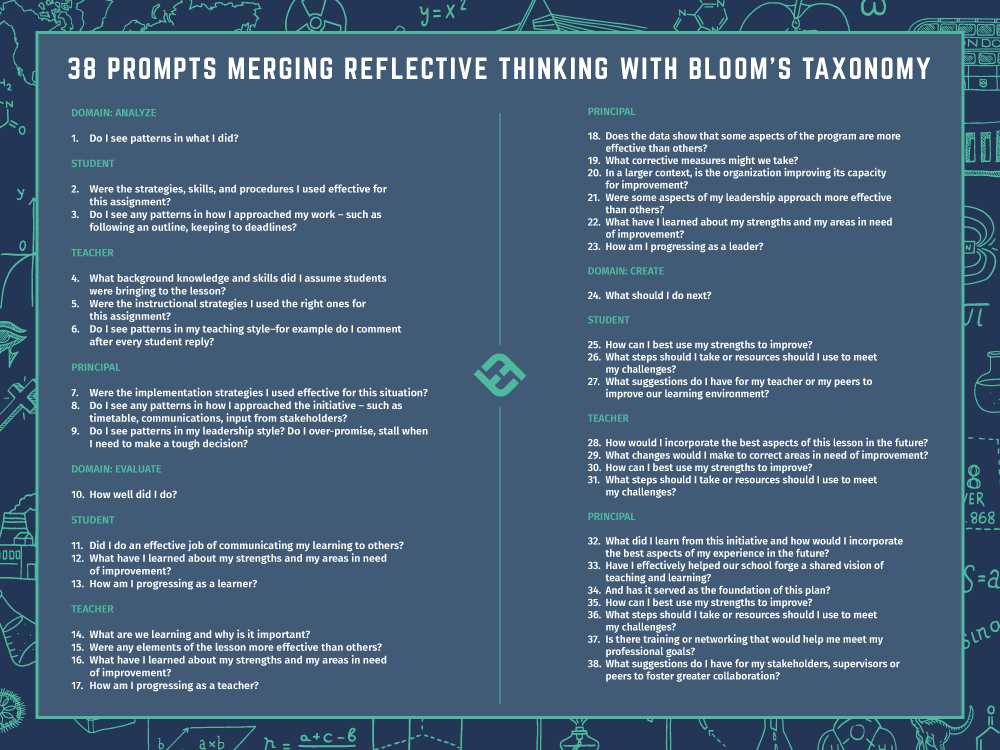
Merge Reflective Thinking With Bloom’s Taxonomy Using These Prompts
contributed by Peter Pappas
My interest in reflective thinking is rooted in a simple but powerful statement by Donald Finkel who wrote that teaching should be thought of as “providing experience, provoking reflection” (Teaching with Your Mouth Shut).
Most school mission statements include a reference to ‘fostering life-long learners.’ Nonetheless, if you walk through some schools you will see adults telling students what’s worth knowing and then evaluating the students on their success. I doubt that inspires students to take responsibility for their education. If students are going to be productive in a dynamic society and workplace they will need to be agile, fluid learners. They need to be encouraged to explore their own approaches and reflect on their progress.
Unfortunately, self-reflection is rarely taught in school. And if students are following prescriptive lessons, there may not be much for them to reflect on. Too often students learn to wait for teachers to tell them how they’re doing. They’re not alone since our standardized ‘test-prep’ school culture now has teachers and administrators caught in an unproductive web of external evaluation.
I developed my Taxonomy of Reflection in an effort to provide a schema of prompts that could be used by students, teachers, and administrators to hone their reflective skills. I used Bloom’s well-known Taxonomy of Thinking Skills since I think that self-reflection has similar ‘levels.’ Consider the stereotypical student response to a parent’s query “What did you do in school today?” The most many parents hope for is an accurate report on what happened.
Seen through Bloom, that’s the equivalent of “Remembering: Retrieving, recognizing, and recalling relevant knowledge from short or long-term memory.” My goal was to develop a system of prompts that would raise students to higher levels of reflection that corresponded with Bloom’s analysis, evaluation, and creation.
As I worked on the student prompts, I realized that the same approach could be used to generate valuable reflective prompts for teachers and administrators.
Below are 38 examples of higher-order reflective prompts. A full collection of prompts at all levels of the taxonomy is available here students, teachers, and principals, and the ‘macro taxonomy’ can be seen towards the bottom of the post.
As always, comments are welcome!
DOMAIN: ANALYZE
1. Do I see patterns in what I did?
Student
2. Were the strategies, skills, and procedures I used effective for this assignment?
3. Do I see any patterns in how I approached my work – such as following an outline, keeping to deadlines?
Teacher
4. What background knowledge and skills did I assume students were bringing to the lesson?
5. Were the instructional strategies I used the right ones for this assignment?
6. Do I see patterns in my teaching style–for example do I comment after every student reply?
Principal
7. Were the implementation strategies I used effective for this situation?
8. Do I see any patterns in how I approached the initiative – such as timetable, communications, input from stakeholders?
9. Do I see patterns in my leadership style? Do I over-promise, stall when I need to make a tough decision?
DOMAIN: EVALUATE
10. How well did I do?
Student
11. Did I do an effective job of communicating my learning to others?
12. What have I learned about my strengths and my areas in need of improvement?
13. How am I progressing as a learner?
Teacher
14. What are we learning and why is it important?
15. Were any elements of the lesson more effective than others?
16. What have I learned about my strengths and my areas in need of improvement?
17. How am I progressing as a teacher?
Principal
18. Does the data show that some aspects of the program are more effective than others?
19. What corrective measures might we take?
20. In a larger context, is the organization improving its capacity for improvement?
21. Were some aspects of my leadership approach more effective than others?
22. What have I learned about my strengths and my areas in need of improvement?
23. How am I progressing as a leader?
DOMAIN: CREATE
24. What should I do next?
Student
25. How can I best use my strengths to improve?
26. What steps should I take or resources should I use to meet my challenges?
27. What suggestions do I have for my teacher or my peers to improve our learning environment?
Teacher
28. How would I incorporate the best aspects of this lesson in the future?
29. What changes would I make to correct areas in need of improvement?
30. How can I best use my strengths to improve?
31. What steps should I take or resources should I use to meet my challenges?
Principal
32. What did I learn from this initiative and how would I incorporate the best aspects of my experience in the future?
33. Have I effectively helped our school forge a shared vision of teaching and learning?
34. And has it served as the foundation of this plan?
35. How can I best use my strengths to improve?
36. What steps should I take or resources should I use to meet my challenges?
37. Is there training or networking that would help me meet my professional goals?
38. What suggestions do I have for my stakeholders, supervisors or peers to foster greater collaboration?
Peter Pappas is an experienced educator whose workshops are based on the premise that staff development should model what we expect to see in the classroom. Five years ago he relocated to Portland Oregon to continue his work as trainer/writer and currently teaches social studies methods at University of Portland. He has published a series of innovative multi-touch iBooks. His popular blog, Copy/Paste features free downloads of instructional resources, projects and publications. Follow him at Twitter @edteck; 44 Prompts Merging Reflective Thinking With Bloom’s Taxonomy